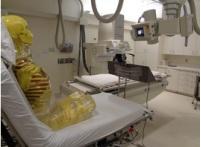June 12, 2014
By Lisa Chamoff, DOTmed contributing reporter
Most radiologic technologists know that it’s best to stand six feet away from the patient during an exam, but they may not be aware that a small amount of scatter is still created – in some cases, it’s enough to make the tech’s hand bones clearly visible.
Dennis Bowman, who works as radiographer at a hospital on California’s Central Coast and also lectures on best dose practices in radiography through his company, Digital Radiography Solutions, recently conducted an experiment to measure just how much scatter is created by an anteroposterior chest X-ray. The results were recently re-posted on the website for the California Society of Radiologic Technologists.
“If you’re in the room, you’re getting radiated,” Bowman told DOTmed News. “It’s not very much, (but) most techs think that if you’re more than six feet away that it’s nothing.”
For the experiment, Bowman and his team set up a facsimile of a patient in a gurney using abdomen, thorax and head/neck phantoms. They then used a Fluke 150 cc diagnostic ionization chamber and dosimeter and measured the scatter at one foot from the patient out until the reading showed zero, and at 0, 45 and 90 degrees. For all of the experiments, they put either a plain CR cassette or a gridded CR cassette behind the fake patient’s thorax. Another experiment used a hand phantom, meant to be the hand of the radiographer, and a CR cassette.

The study found that even at 12 feet away, there was enough radiation scattering from the patient to penetrate the radiographer’s hand and show the bones. The ion chamber was far less sensitive than the 1200 speed CR cassette, so images of the hand could still be taken even though the dosimeter was reading zero. The badge monitors that radiographers wear are also incapable of picking up such minute radiation, Bowman said.
The daily radiation exposure for the average person is 320 mrem per year, according to data from the National Council on Radiation Protection & Measurements, which Bowman worked out to be 844 microR a day. With that in mind, the average dose of 6.5 microR that a radiographer gets when standing 6 feet away from the patient at 90 degrees, or even the 33.6 microR that they get from standing in front of the patient, is insignificant, but Bowman said it can add up. When shooting five portable chest X-rays in a day, you could already double the dose you will naturally get in a given day, he said.
“I’ve probably done 50,000 portable chests in my career,” Bowman said. “It could be argued that that amount of X-ray is so small that it doesn’t matter, but that hasn’t been proven to be true.”
Bowman recommends that a radiographer, aside from always wearing a full lead apron with a thyroid shield, stand behind the tower of the portable machine when doing mobile X-rays, between 45 and 90 degrees from the patient.
Protective Apparel , Protective Barriers , Protective Monitoring
“As soon as your brain says ‘now,’ you pull your head back really quick and take the exposure,” Bowman said. “In the half a second you’ve completely hidden your eyes and your thyroid.”

Hello, very interesting article. I am curious if you may have any figures compiled relating to exposure when using a C-Arm? I work in pain management and have been doing fluoro for cases for 17 of the 18 years that I’ve been a tech. Thanks in advance for any info you may have.